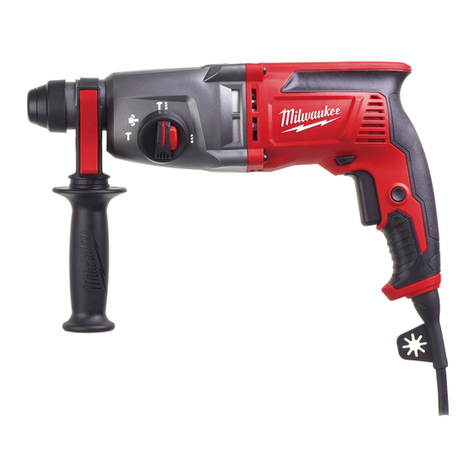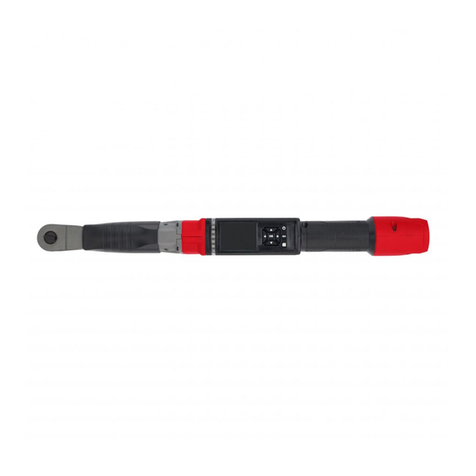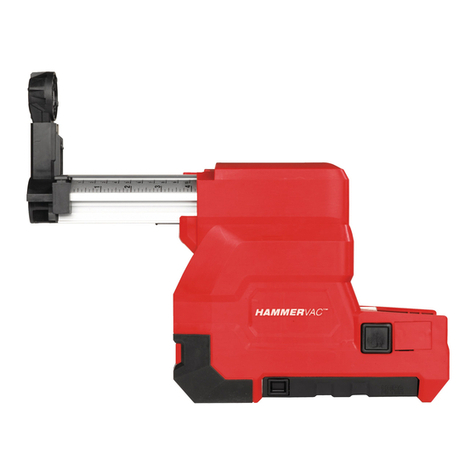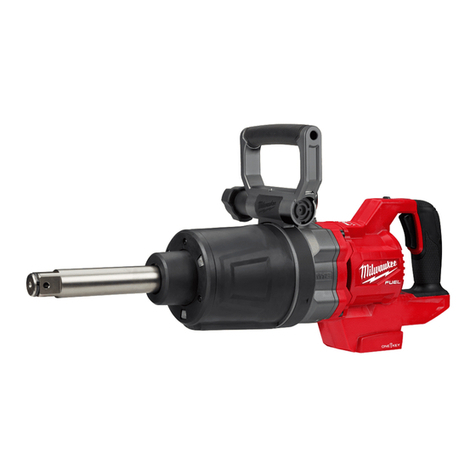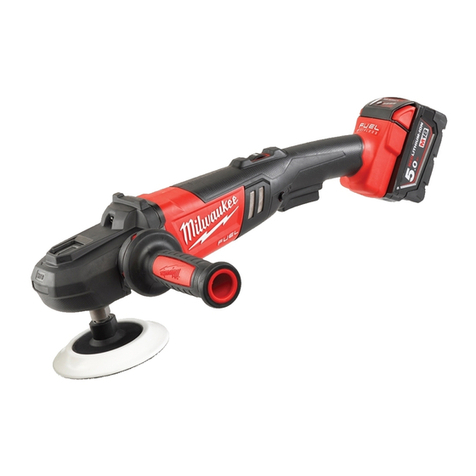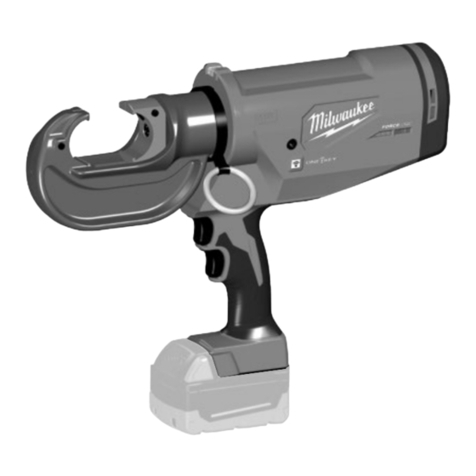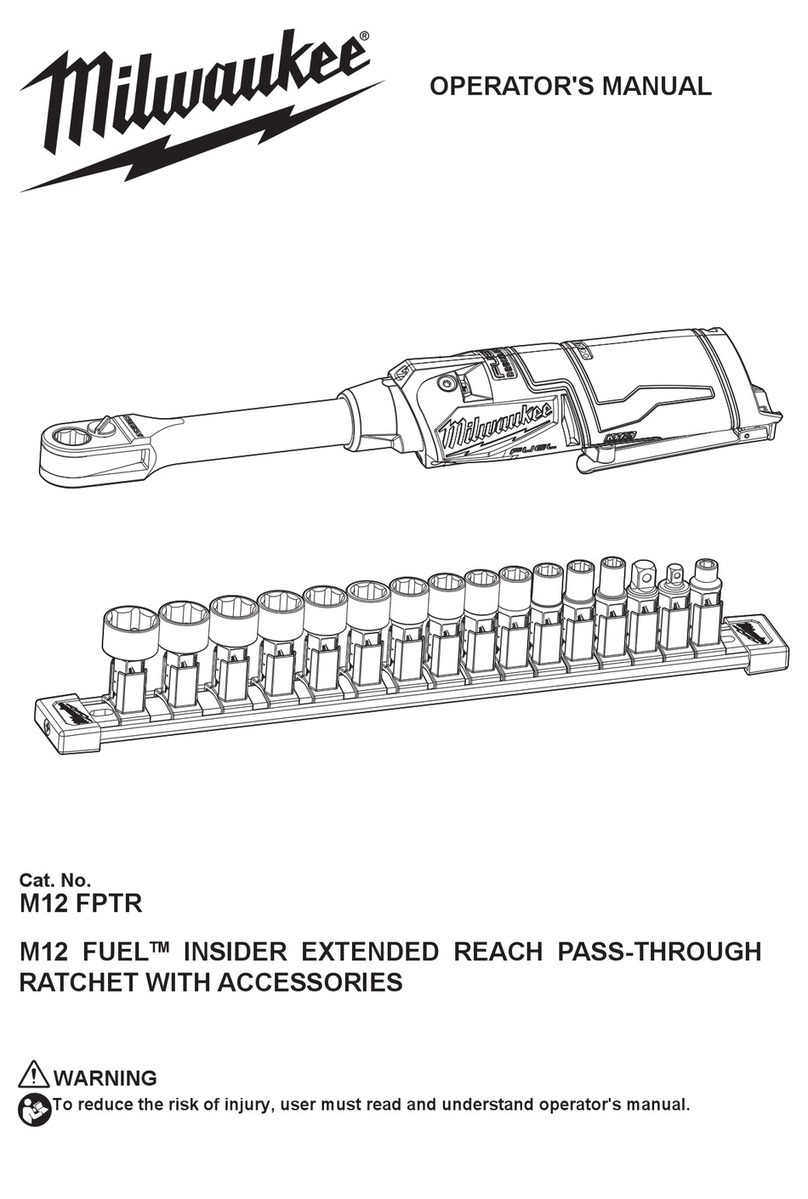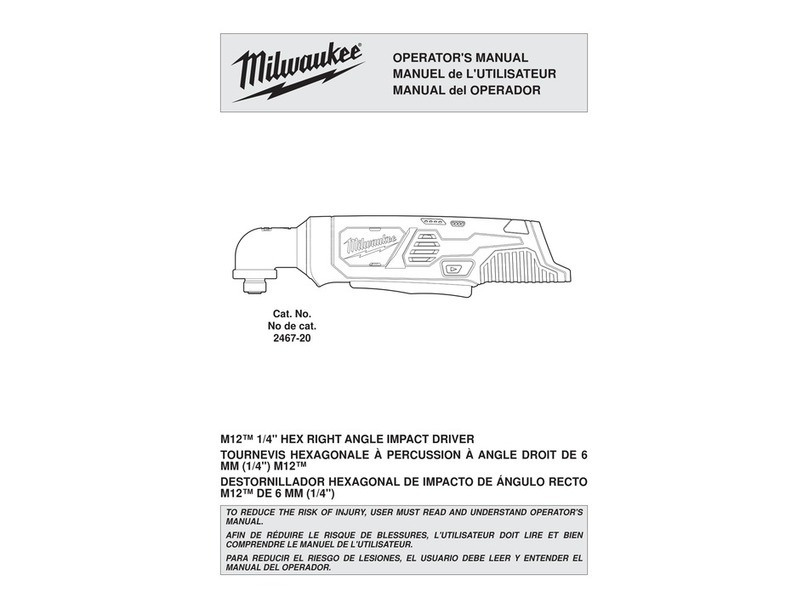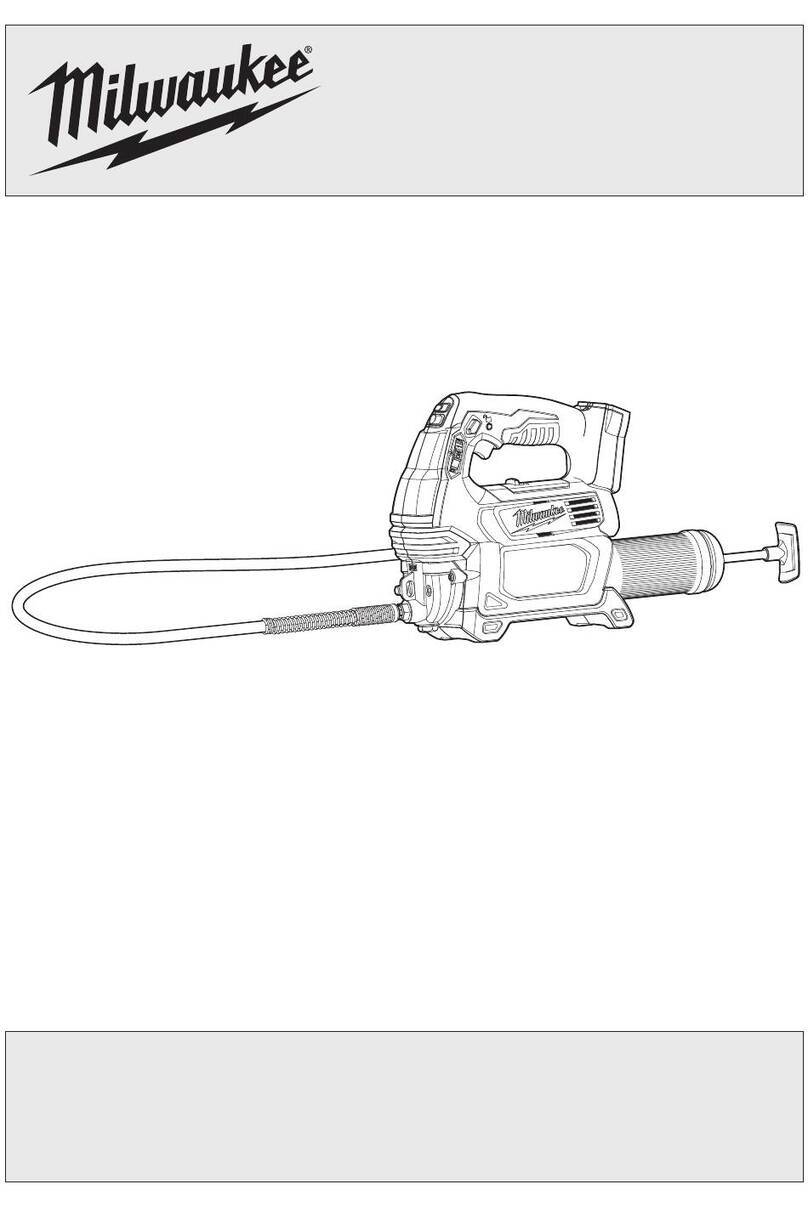Cat. No.
2462-20
•Hold power tool by insulated gripping sur-
faces, when performing anoperation where the
fastener may contact hidden wiring. Fasteners
contacting a “live” wire may make exposed metal
parts of the power tool “live” and could give the
operator an electric shock.
•Wear ear protectors. Exposure to noise can
cause hearing loss.
•Keep hands away from all cutting edges and
moving parts.
•Maintain labels and nameplates. These carry
important information. If unreadable or missing,
contact a MILWAUKEE service facility for a free
replacement.
•WARNING: Some dust created bypowersanding,
sawing, grinding, drilling, and other construction
activities contains chemicals known to cause
cancer, birth defects or other reproductive harm.
Some examples of these chemicals are:
•lead from lead-based paint
•crystalline silica from bricks and cementandother
masonry products, and
•
arsenicandchromiumfromchemically-treatedlumber.
Your risk fromthese exposures varies, depending
on how often you do this type of work. To reduce
your exposure to these chemicals: work in a well
ventilated area, and work with approved safety
equipment,such as those dustmasksthat are spe-
cially designed to filter out microscopic particles.
FUNCTIONAL DESCRIPTION
SPECIFICATIONS
Cat. No. Volts DC RPM Drive Shank IPM
2461-20
2462-20
2463-20
12
12
12
0-2500
0-2500
0-2500
1/4" square
1/4" Hex
3/8" Square
0-3800
0-3300
0-3300
PERSONAL SAFETY
GENERAL POWER TOOL SAFETY WARNINGS
WORK AREA SAFETY
ELECTRICAL SAFETY
•Keep work area clean and well lit. Cluttered or
dark areas invite accidents.
•Do not operate power tools in explosive at-
mospheres, such as in the presence of flam-
mable liquids, gases or dust. Powertoolscreate
sparks which may ignite the dust or fumes.
•Keep children and bystanders away while
operating a power tool. Distractions can cause
you to lose control.
•Power tool plugs must match the outlet. Never
modify the plug in any way. Do not use any
adapter plugs with earthed (grounded) power
tools. Unmodifiedplugs and matching outlets will
reduce risk of electric shock.
•Avoid body contact with earthed or grounded
surfaces such as pipes, radiators, ranges and
refrigerators.Thereis an increasedriskofelectric
shock if your body is earthed or grounded.
•Do notexpose power tools to rainor wet condi-
tions. Water entering a power tool will increase
the risk of electric shock.
•Do not abuse the cord. Never use the cord for
carrying, pulling or unplugging the power tool.
Keep cord away from heat, oil, sharp edges
or moving parts. Damaged or entangled cords
increase the risk of electric shock.
•When operating a power tool outdoors, use an
extension cord suitable for outdoor use. Use
of a cord suitable for outdoor use reduces the risk
of electric shock.
•If operating a power tool in a damp location
is unavoidable, use a residual current device
(RCD) protected supply. Useof an RCD reduces
the risk of electric shock.
•Do not overreach. Keep proper footing and
balance at all times. This enables better control
of the power tool in unexpected situations.
•Dress properly. Do not wear loose clothing or
jewellery. Keep your hair, clothing and gloves
away from moving parts. Loose clothes, jewel-
lery or long hair can be caught in moving parts.
•If devices are provided for the connection of
dust extraction and collection facilities, ensure
these are connected and properly used. Useof
dust collection can reduce dust-related hazards.
WARNING READ ALL SAFETY WARNINGS AND ALL INSTRUCTIONS.
Failure to follow the warnings and instructions may result in electric shock, fire and/or
serious injury. Save all warnings and instructions for future reference.
The term "power tool" in the warnings refers to your mains-operated (corded) power tool or
battery-operated (cordless) power tool.
POWER TOOL USE AND CARE
•Do not force the power tool. Use the correct
power tool for your application. The correct
power tool will do the job better and safer at the
rate for which it was designed.
•Do notuse the power toolif the switch does not
turn it on and off. Any power tool that cannot be
controlled with the switch is dangerous and must
be repaired.
•Disconnect the plug from the power source
and/or the battery pack from the power tool
before making any adjustments, changing
accessories, or storing power tools. Such
preventive safety measures reduce the risk of
starting the power tool accidentally.
•Store idle power tools out of the reach of chil-
dren and do not allow persons unfamiliar with
the power tool or these instructions to operate
the power tool. Powertoolsaredangerousinthe
hands of untrained users.
•Maintain power tools. Check for misalignment
or binding of moving parts, breakage of parts
and any other condition that may affect the
power tool’s operation. If damaged, have the
power tool repaired before use. Manyaccidents
are caused by poorly maintained power tools.
•Keep cutting tools sharp and clean. Properly
maintained cutting tools with sharp cutting edges
are less likely to bind and are easier to control.
•Use the power tool, accessories and tool bits
etc., in accordance with these instructions,
taking into account theworking conditions and
the work to be performed. Use of the power tool
for operations different from those intended could
result in a hazardous situation.
•Stay alert, watch what you are doing and use
common sense when operating a power tool.
Do not use a power tool while you are tired or
under the influence of drugs, alcohol or medi-
cation. A moment of inattention while operating
power tools may result in serious personal injury.
•Use personal protective equipment. Always
wear eye protection. Protective equipment such
as dust mask, non-skid safety shoes, hard hat, or
hearingprotectionusedforappropriateconditions
will reduce personal injuries.
•Prevent unintentional starting. Ensure the
switch is in the off-position before connecting
to power source and/or battery pack, picking
up or carrying the tool. Carryingpowertools with
yourfingeron the switch or energising power tools
that have the switch on invites accidents.
•Remove any adjusting key or wrench before
turning the power tool on. Awrench or a key left
attached to a rotating part of the power tool may
result in personal injury.
•Recharge only with the charger specified by
the manufacturer. A charger that is suitable for
one type of battery pack may create a risk of fire
when used with another battery pack.
•Use power tools only with specifically desig-
nated battery packs. Use of any other battery
packs may create a risk of injury and fire.
•When battery pack is not in use, keep it away
from other metal objects like paper clips,
coins, keys, nails, screws, or other small metal
objects that can make a connection from one
BATTERY TOOL USE AND CARE
SPECIFIC SAFETY RULES
terminal to another. Shorting the battery termi-
nals together may cause burns or a fire.
•
Underabusive conditions, liquid may beejected
from the battery; avoid contact. If contact ac-
cidentally occurs, flush with water. If liquid con-
tactseyes, additionally seek medicalhelp. Liquid
ejectedfromthebatterymaycauseirritationorburns.
SERVICE
•Have your power tool serviced by a qualified
repair person using only identical replacement
parts. Thiswillensurethatthesafetyofthepower
tool is maintained.
5
4
321
SYMBOLOGY
1.Trigger
2.Control switch
3.LED
4.Drive Shank
5.Fuel Gauge
6. 1/4" square drive
7. 3/8" square drive
Cat. No.
2461-20
6
Cat. No.
2463-20
7
Volts
Direct Current
Impacts per Minute Under
Load (IPM)
No Load Revolutions per
Minute (RPM)
Underwriters Laboratories, Inc.
United States and Canada
ASSEMBLY
WARNING Recharge only with the
charger specified for the battery. For specific
charging instructions, read the operator’s
manualsuppliedwith yourchargerand battery.
Inserting/Removing the Battery
To remove the battery, push in the release buttons
and pull the battery pack away from the tool.
To insert the battery, slide the pack into the body
ofthetool.Makesureit latches securely into place.
WARNING Use only sockets and other
accessories specifically designed for
use on impact wrenches and drivers. Other
sockets and accessories might shatter or
break causing injury.
WARNING Always remove battery
pack before changing or removing accesso-
ries. Only use accessories specifically recom-
mendedforthistool.Othersmaybehazardous.
Attaching and Removing Accessories
These tools are intended only for use with acces-
sories designed for impact wrenches and drivers.
Othersocketscould shatter orbreak,causinginjury.
Cat. No. 2462-20
This driver is intended for use with drill and driver
bits with a 1/4" hex shank and ball detent recess.
1. To attach an accessory, pull the ring
out and insert the accessory shank.
Release the ring. It may be necessary
to pull the bit out slightly to engage the
holding mechanism.
2. To remove the accessory, pull out the
ring and remove the accessory. Re-
lease the ring.
Cat. No. 2461-20 and 2463-20
1. To attach a socket, align the accessory with the
driveshankandpushitfirmlyovertheretainingring.
2. To remove the accessory, pull the accessory off
the drive shank.

